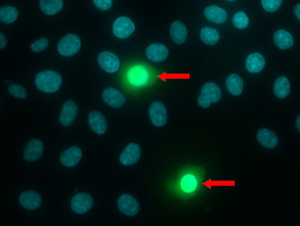The NUCLEAR-ID® Blue/Green cell viability reagent (Prod. No. ENZ-53004) is a mixture of a blue fluorescent cell-permeable nucleic acid dye and a green fluorescent cell-impermeable nucleic acid dye that is suited for staining dead nuclei. The staining pattern arising from the simultaneous combination of these two dyes permits determination of live and dead cell populations by fluorescence/confocal microscopy. The reagent, supplied as a 1000x solution, is sufficient for 1000 microscopy assays. The single-tube format makes this cell viability reagent easy to use. It leaves the cytoplasm unstained, potentially allowing visualization of other cell markers.
Product Details
| Quantity: | 100μl (for 1000 microscopy assays). |
| |
| Purity: | ≥93% (HPLC) |
| |
| Applications: | Flow Cytometry, Fluorescence microscopy, Fluorescent detection
|
| |
| Shipping: | Dry Ice |
| |
| Short Term Storage: | -20°C |
| |
| Long Term Storage: | -80°C |
| |
| Handling: | Protect from light. Avoid freeze/thaw cycles. |
| |
| Technical Info/Product Notes: | Wavelength Maxima
Live (Blue): Excitation: 350nm; Emission: 461nm
Dead (Green): Excitation: 503nm; Emission: 524nm
The NUCLEAR-ID® Blue/Green cell viability reagent is a member of the CELLESTIAL® product line, reagents and assay kits comprising fluorescent molecular probes that have been extensively benchmarked for live cell analysis applications. CELLESTIAL® reagents and kits are optimal for use in demanding imaging applications, such as confocal microscopy, flow cytometry and HCS, where consistency and reproducibility are required. |
| |
| Protocol: | Wide Field Fluorescence/Confocal Microscopy
Reagent Preparation:
Mix 1μL of NUCLEAR-ID® Blue/Green Cell Viability Reagent in 1 mL of buffer of choice. This volume is sufficient for 10 assays and may be scaled according to need.
Staining Adherent cells:- Grow cells directly onto glass slides or polystyrene tissue culture plates until ~80% confluent via standard tissue culture practices.
- Remove growth media.
- Dispense the freshly diluted staining solution in a volume sufficient for covering the cell monolayer.
- Remove the excess staining solution and, if necessary, add a few drops of buffer to prevent the cells from drying out.
- Cover cells with a glass cover slip and observe under a fluorescence/confocal microscope with a dual filter set for DAPI (Ex/Em: 350/470nm) and GFP/FITC (Ex/Em: 488/514 nm).
Staining Non-Adherent Cells:Grow cells via standard tissue culture practices. - Collect about 1 x 105 cells. Centrifuge at 500 x g for 5 minutes. Remove supernatant.
- Re-suspend cells in a volume of the freshly diluted staining solution sufficient for covering the cell pellet.
- Protect samples from light and incubate for 30 minutes at 37°C.
- Centrifuge at 500 x g for 5 minutes. Remove supernatant.
- Re-suspend cells in 100µL buffer
- Plate 10-15µL of cells on a glass slide.
- 8. Cover cells with a glass cover slip and observe under a fluorescence/confocal microscope with a dual filter set for DAPI (Ex/Em: 350/470nm)and GFP/FITC (Ex/Em: 488/514 nm).
|
| |
| Regulatory Status: | RUO - Research Use Only |
| |

Figure 1: The NUCLEAR-ID® Blue/Green dye is detected as blue-stained nuclei in live cells and fluorescent-green nuclei in dead cells (arrows).
Please mouse over
Product Literature References
In situ cross-linked electrospun fiber scaffold of collagen for fabricating cell-dense muscle tissue: N. Takeda, et al.; J. Artif. Organs
19, 141 (2016),
Abstract;
Analysis of protein translocation into the endoplasmic reticulum of human cells: J. Dudek, et al.; Methods Mol. Biol.
1033, 285 (2013),
Abstract;
Phenotypic switch in blood: effects of pro-inflammatory cytokines on breast cancer cell aggregation and adhesion: Y. Geng, et al.; PLoS One
8, e54959 (2013),
Application(s): Breast cancer cell viability observed by confocal microscopy,
Abstract;
Full Text
Different effects of Sec61α, Sec62 and Sec63 depletion on transport of polypeptides into the endoplasmic reticulum of mammalian cells: S. Lang, et al.; J. Cell. Sci.
125, 1958 (2012),
Application(s): Viability of HeLa cells analyzed using automated cell counter,
Abstract;
Full Text
Comparative gene responses to collected ambient particles in vitro: endothelial responses: H.H. Aung, et al.; Physiol. Genomics
43, 917 (2011),
Application(s): Cell viability of human aortic endothelal cells,
Abstract;
Full Text
Interaction of calmodulin with Sec61α limits Ca2+ leakage from the endoplasmic reticulum: F. Erdmann, et al.; EMBO J.
30, 17 (2011),
Application(s): Cell viability of HeLa cells,
Abstract;
Full Text
Live cell calcium imaging combined with siRNA mediated gene silencing identifies Ca²⁺ leak channels in the ER membrane and their regulatory mechanisms: S. Lang, et al.; J. Vis. Exp.
53, e2730 (2011),
Application(s): Cell viability of siRNA-transfected cells,
Abstract;
Full Text
General Literature References
Constitutive expression of the machinery for programmed cell death: M. Weil, et al.; J. Cell Biol.
133, 1053 (1996),
Abstract;
Principles and Methods of Toxicology, Third Edition: A.W. Hayes, Ed.; Raven Press 1231 (1994), Book,
Related Products















